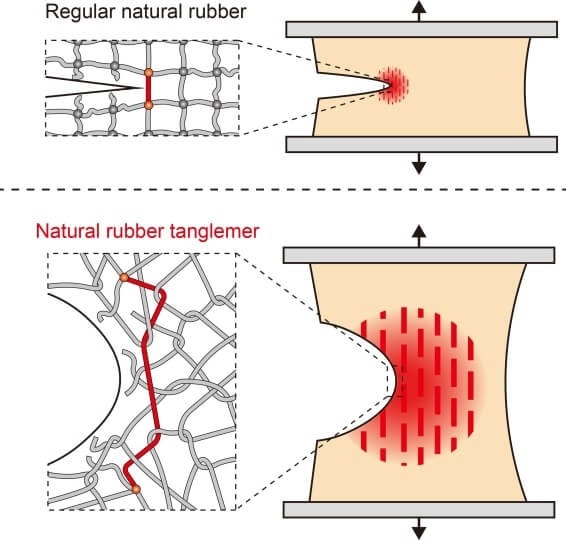Materials scientists at the Harvard John A. Paulson School of Engineering and Applied Sciences (SEAS) have developed a method for creating natural rubber that significantly increases its resistance to cracking even after numerous cycles of use while maintaining its essential qualities of stretchiness and durability, according to a study published in Nature Sustainability.
 In the new rubber tanglemer, a long polymer strand at a crack tip de-concentrates stress over a long distance, making the material more resistant to crack growth than regular natural rubber. Image Credit: Harvard John A. Paulson School of Engineering and Applied Sciences
In the new rubber tanglemer, a long polymer strand at a crack tip de-concentrates stress over a long distance, making the material more resistant to crack growth than regular natural rubber. Image Credit: Harvard John A. Paulson School of Engineering and Applied Sciences
Humans have been using natural rubber, one of the most widely produced biomaterials worldwide, for thousands of years. However, until now, its resistance to crack formation has not improved much in decades.
The study was led by Zhigang Suo, Allen E. and Marilyn M. Puckett Professor of Mechanics and Materials at SEAS.
Improving crack resistance will extend the material’s service lifetime and therefore improve its sustainability.
Guodong Nian, Study First Author and Postdoctoral Researcher, Harvard John A. Paulson School of Engineering and Applied Sciences
Natural rubber is a long-lasting polymer found in many products, including gloves, tires, shoes, medical devices, and conveyor belts.
Rubber is extracted from natural rubber latex, a milk-like fluid found in the Hevea tree. It is then coagulated, dried, blended with additives, shaped, and heated to initiate vulcanization. This method results in short polymer chains within the material that are highly crosslinked, or chemically bonded.
The researchers adjusted this long-standing, high-intensity technique to produce a gentler transformation that keeps long polymer chains in their natural condition rather than chopping them into shorter ones. Their so-called rubber “tanglemer,” which resembles tangled spaghetti, increases the new product's durability by replacing crosslinks with entanglements.
Nian added, “We used a low-intensity processing method, based on latex processing methods, that preserved the long polymer chains.”
When a crack emerges in the new material, the long spaghetti strands distribute the stress by sliding past each other. This allows more rubber to crystallize as it stretches and makes the material stronger and more resistant to breaking.
Zheqi Chen, a former SEAS postdoctoral researcher and study co-first author, stated that their findings exceeded their expectations. During repeated stretching, the rubber improved its ability to resist gradual crack formation by fourfold and became ten times harder overall.
We imagined that the properties would be enhanced maybe twice or three times, but actually they were enhanced by one order of magnitude.
Zheqi Chen, Former Postdoctoral Researcher, Harvard John A. Paulson School of Engineering and Applied Sciences
The study emphasizes the importance of keeping the natural condition of long polymer chains. However, difficulties remain: the new material processing requires substantial water evaporation, resulting in a lower volume of material than would be acceptable for items such as tires.
It is best suited for thin rubber products such as gloves or condoms. Other possibilities opened up by the new method include flexible electronics and soft robotics parts.
Xianyang Bao (first author), Matthew Wei Ming Tan, and Yakov Kutsovsky co-authored the study. The National Science Foundation's Materials Research Science and Engineering Centers (DMR-2011754) and the Air Force Office of Scientific Research’s award No. GA9550-20-1-0397 provided financial support for the study.
Developing Natural Rubber that Stretches Without Cracking
Video Credit: Harvard John A. Paulson School of Engineering and Applied Sciences
Journal Reference:
Nian, G. et al. (2025) Natural rubber with high resistance to crack growth. Nature Sustainability. doi.org/10.1038/s41893-025-01559-z